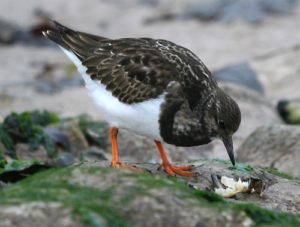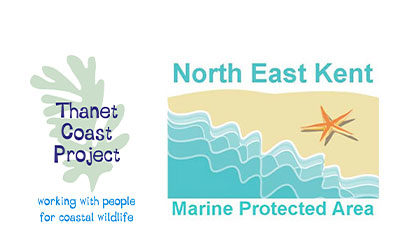‘Your turn’ to help the Turnstone

Turnstone feed and rest along the North East Kent shores in internationally important numbers during the winter months (October to March). However they are not doing as well as they could be!
Turnstone can be scared by fast movements caused by people or dogs that get too close, and will run or fly away. This disturbance stops them from feeding or resting, and can prevent them from putting on enough body fat to survive harsh weather or their long migration flight.
This video was created by local teenagers with support from Children’s Play’ Big Lottery Funded project in Thanet (2008-11) . Turnstone image above by Willie McKnight.
Faithful
Turnstone are ‘faithful’ to a particular bay, and return each winter from Canada and the tundra to feed along these rocky shores. They feed on small marine life such as crabs and shrimps by turning over loose stones and seaweed with their bills to find them.
Peace ‘at night’ and ‘high tide’!
Turnstone need to be left alone to rest – or ‘roost’. They gather in groups at night and high tide, and tend to rest in undisturbed sheltered locations, close to their feeding grounds. But because of disturbance, fewer birds are using these roost sites and are flying further away – using up valuable energy.
Action speaks louder than birds!
There are simple actions that everyone can do to reduce disturbance and not put the Turnstone to flight, such as:
- keeping your distance from the resting or feeding birds,
- slowing your movement, and also
- keeping your dog on a lead when near them.
More information
Research:
Natural England commissioned research surveys to monitor the Turnstone every two to three years from 2002 to 2018. The NEKMPA Coastal Wardens assisted the Sandwich Bay Bird Observatory Trust to monitor numbers and disturbance. The 2013 & 2014 monitoring report (PDF 688kb) had shown a huge 50% decline in the numbers of Turnstone, and this has been confirmed by the most recent reports in 2016 Turnstone Monitoring report (PDF, 1,073kb), and 2018 Turnstone Report (PDF, 876KB). This report has been issued by Natural England/Thanet Coast Project (Thanet Council) – with help from volunteers from the Thanet Coast Project (NEKMPA Coastal Wardens), Sandwich Bay Bird Observatory Trust, Local RSPB Group, BTO members – with support from Thanet Council.
More recent surveys in January to February 2019 (Footprint Ecology) & in Jan-February 2020 (SBBOT) were carried out as part of the Strategic Access Management and Monitoring Plan (see SAMM below) funding a new Bird Wise project to help reduce disturbance and engage with local people.
Local Action:
Turnstone signs are displayed close to the main winter roost sites.
The sign information has been reviewed with help from the Thanet Coastal Wardens and these signs and stickers (sample PDF 101kb) may be seen in the vicinity of roost sites. Information poster (PDF 603kb) are also available to download.
However, we rely on your help to avoid – or reduce your movement – close to these sites at high tide, or at night.
Some of the High Tide Roost were should on signs in the Thanet area from 2004 to 2023: Reculver to Birchington sign (PDF, 589kb); Westgate sign (PDF, 587kb); Cliftonville to Kingsgate sign (PDF, 609kb); Margate sign (PDF, 592kb). Some new signs were funded by the Thanet RSPB local group for signs around the Foreness point to Botany Bay coast – with another near Margate harbour’s high tide and night bird roost: Please Let Me Rest! (30cm diameter; PDF 101kb)
2023 England Coastal Path: – Ramsgate to Whitstable

New Turnstone awareness signs are to be produced as part of the Habitat Regulations Assessment work for Natural England/Thanet Council for the Thanet Coast SPA (Special Protection Area) to help reduce disturbance over the winter months.
Turnstones & SAMM: ‘Bird Wise East Kent’
Thanet and Canterbury Council Planners have an initiative commissioned as part of the mitigation measures for future development and people pressure (‘SAMM’). A ‘baseline’ count by consultants ‘Footprint Ecology’ for a bird and people count was held with some face to face interviews with people at 8 locations around the Thanet Coast SPA. More information, see:
Thanet wader & visitor survey report – Jan-Feb 2019, Footprint Ecology (8.7MB, PDF)
Wading Bird Monitoring of the Thanet Coast SPA – Jan-Feb 2020, SBBOT (384KB, PDF)
Sandwich & Pegwell Bay National Nature Reserve (NNR) – Management Plan
Access Restrictions 2023 – Sandwich & Pegwell Bay NNR (PDF, 934KB)
The Sandwich & Pegwell Bay NNR Steering Group are developing a new recreational strategy for the NNR as part of the revised NNR Management Plan. This study and work is led by the Kent Wildlife Trust on behalf of all the NNR landowners/partners. There is online advice on how to reduce disturbance to seals within the NNR.

